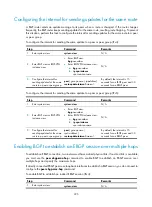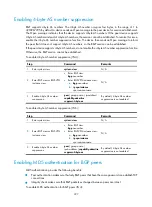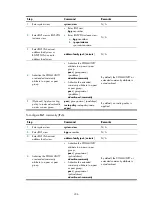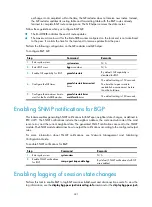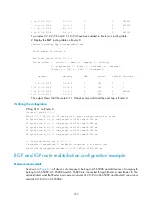
237
Step Command
Remarks
5.
(Optional.) Apply a routing
policy to routes advertised to
a peer or peer group.
peer
{
group-name
|
ipv6-address
}
route-policy
route-policy-name
export
By default, no routing policy is
applied.
Configuring BGP route reflection
Configuring a BGP route reflector
Perform this task to configure a BGP route reflector and its clients. The route reflector and its clients
automatically form a cluster identified by the router ID of the route reflector. The route reflector forwards
route updates among its clients.
To improve availability, you can specify multiple route reflectors for a cluster. The route reflectors in the
cluster must have the same cluster ID to avoid routing loops.
To configure a BGP route reflector (IPv4):
Step Command
Remarks
1.
Enter system view.
system-view
N/A
2.
Enter BGP view or BGP-VPN
instance view.
•
Enter BGP view:
bgp
as-number
•
Enter BGP-VPN instance view:
a.
bgp
as-number
b.
ip vpn-instance
vpn-instance-name
N/A
3.
Enter BGP IPv4 unicast
address family view or
BGP-VPN IPv4 unicast
address family view.
address-family ipv4
[
unicast
]
N/A
4.
Configure the router as a route
reflector and specify a peer or
peer group as its client.
peer
{
group-name
|
ip-address
}
reflect-client
By default, no route reflector or
client is configured.
5.
Enable route reflection
between clients.
reflect between-clients
By default, route reflection
between clients is enabled.
6.
(Optional.) Configure the
cluster ID of the route reflector.
reflector cluster-id
{
cluster-id
|
ip-address
}
By default, a route reflector uses its
own router ID as the cluster ID.
To configure a BGP route reflector (IPv6):
Step Command
Remarks
1.
Enter system view.
system-view
N/A
2.
Enter BGP view.
bgp
as-number
N/A
3.
Enter BGP IPv6 unicast
address family view.
address-family ipv6
[
unicast
]
N/A
4.
Configure the router as a route
reflector and specify a peer or
peer group as its client.
peer
{
group-name
|
ipv6-address
}
reflect-client
By default, no route reflector or
client is configured.



